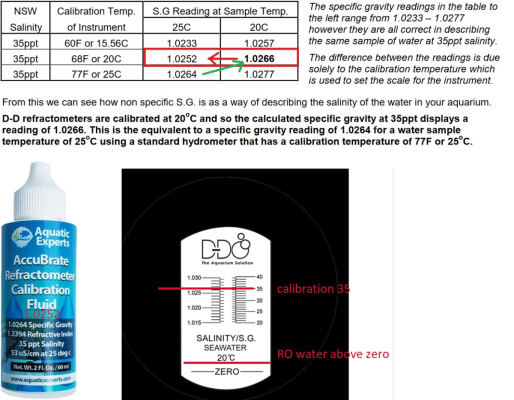Let me apologize up front for raising some questions that have likely been answered many times.
I have spent hours reading articles and threads on this website and results from google searches on this subject. Every time I think I've got it straight in my mind, something comes up that takes me back a couple of steps. Perhaps I'm spending too much time trying to understand the details when the answers are simple. These issues come in to play for me when I'm mixing salt and water at different temperatures and then adding the mix to an aquarium which may be at a different temperature. My guess is that in most cases the differences in salinity I encounter are not material enough to warrant concern. But, I still want to understand.
Scenario 1: I have a refractometer that indicates thru the eyepiece that it is calibrated at 20 degrees C (68 degrees F). The instructions say the ATC (automatic temperature compensation) to function correctly, the ambient temperature of the room must be 20 degrees C when calibrated. When calibrated at this temperature, the accuracy of the device at other temperatures between 10C and 30C will not be affected due to ATC. Question: If I calibrate at 77degrees F using a solution with a known specific gravity at that temperature, will the accuracy of the device for samples from my aquariums at the same temperature (77) be accurate. Getting the room temperature to 20 degrees C to recalibrate does not happen very often, particularly in the summer. I assume the ATC ability of the device will be compromised since it was calibrated at 77 degrees and therefore temperatures +/- 5 or 10 degrees would produce erroneous readings. I also assume that specific gravity/temperature/salinity conversion tables provide no value or need for this scenario?
Scenario 2: I have a hydrometer that was calibrated at 20 degrees C (68 degrees F). My water temperature in my tank is 77 degrees. To determine the actual salinity, I should use a conversion table that was calibrated at 20 degrees C using the measured hydrometer specific gravity cross referenced to 77 degrees F (25 degrees C) t? A conversion table calibrated at 25 degrees C would be useless?
Scenario 3: I have a swing arm meter. Generally, swing arm meters are not temperature dependent? If I have a sample with a known specific gravity or known salinity, I can confirm the swing arm is accurately, or not accurately calibrated? Conversion tables are not needed?
Thanks for your help!
I have spent hours reading articles and threads on this website and results from google searches on this subject. Every time I think I've got it straight in my mind, something comes up that takes me back a couple of steps. Perhaps I'm spending too much time trying to understand the details when the answers are simple. These issues come in to play for me when I'm mixing salt and water at different temperatures and then adding the mix to an aquarium which may be at a different temperature. My guess is that in most cases the differences in salinity I encounter are not material enough to warrant concern. But, I still want to understand.
Scenario 1: I have a refractometer that indicates thru the eyepiece that it is calibrated at 20 degrees C (68 degrees F). The instructions say the ATC (automatic temperature compensation) to function correctly, the ambient temperature of the room must be 20 degrees C when calibrated. When calibrated at this temperature, the accuracy of the device at other temperatures between 10C and 30C will not be affected due to ATC. Question: If I calibrate at 77degrees F using a solution with a known specific gravity at that temperature, will the accuracy of the device for samples from my aquariums at the same temperature (77) be accurate. Getting the room temperature to 20 degrees C to recalibrate does not happen very often, particularly in the summer. I assume the ATC ability of the device will be compromised since it was calibrated at 77 degrees and therefore temperatures +/- 5 or 10 degrees would produce erroneous readings. I also assume that specific gravity/temperature/salinity conversion tables provide no value or need for this scenario?
Scenario 2: I have a hydrometer that was calibrated at 20 degrees C (68 degrees F). My water temperature in my tank is 77 degrees. To determine the actual salinity, I should use a conversion table that was calibrated at 20 degrees C using the measured hydrometer specific gravity cross referenced to 77 degrees F (25 degrees C) t? A conversion table calibrated at 25 degrees C would be useless?
Scenario 3: I have a swing arm meter. Generally, swing arm meters are not temperature dependent? If I have a sample with a known specific gravity or known salinity, I can confirm the swing arm is accurately, or not accurately calibrated? Conversion tables are not needed?
Thanks for your help!
















